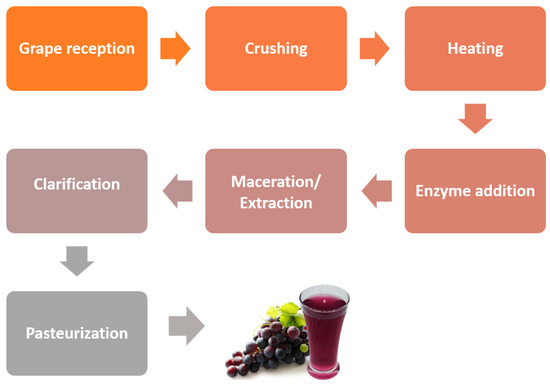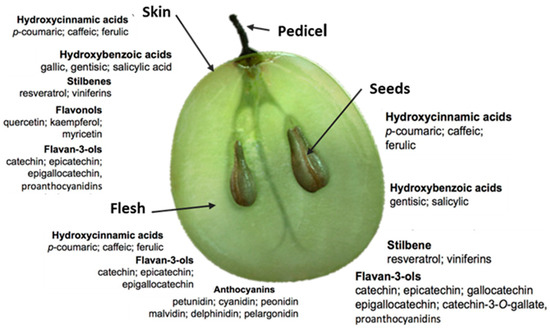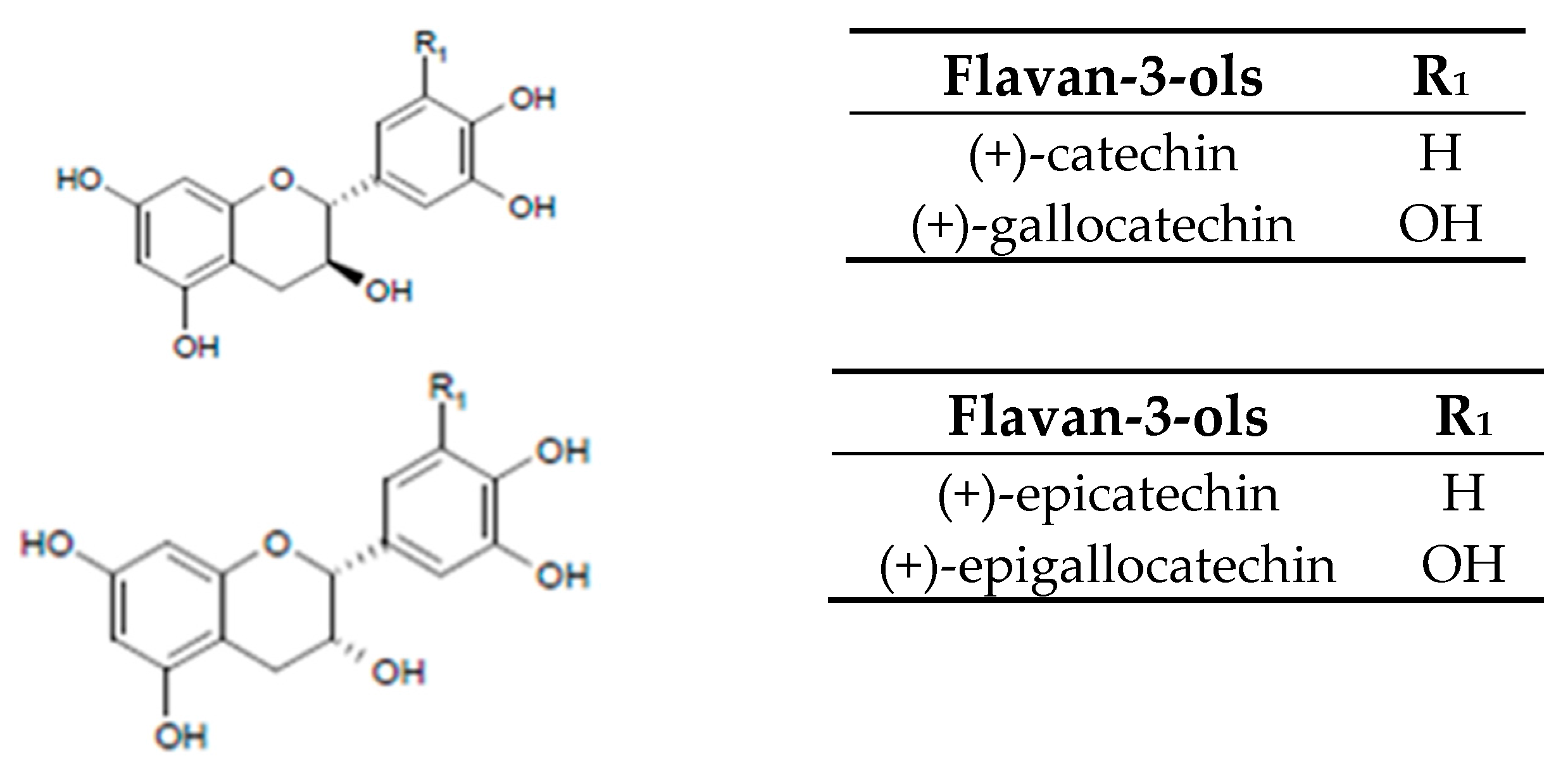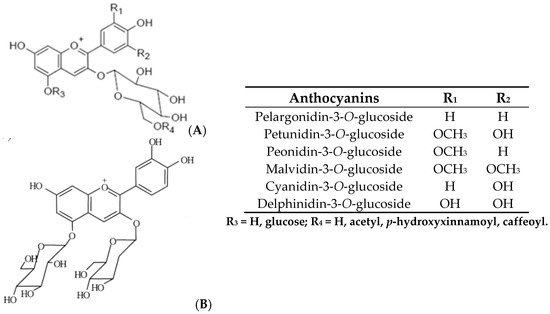2. Grape Juice Production and Phenolic Composition
Grape juice world production is estimated to be between 11 and 12 million hectolitres, where the primary producing and consuming countries of this beverage are the United States of America, Brazil, and Spain
[10][11]. In many European countries, grape juice is made from
Vitis vinifera grape varieties
[11][12]. However, the main cultivars used for juice production in the United States are mainly Concord and Muscadine (
Vitis rotundifolia) cultivars
[12][13][13,14]. Juices from Brazil are produced from American and hybrid grape varieties; the
Vitis labrusca cultivars “Isabel,” “Bordô,” and “Concord” are the base for Brazilian grape juices
[14][15]. Among the grape varieties of
Vitis labrusca, the Concord variety is the most used for producing grape juice because it has a very aromatic juice with good nutritional properties and is well-accepted by consumers
[15][16]. The “Isabel Precoce” (
Vitis labrusca), originating from a spontaneous somatic mutation of the “Isabel” cultivar, presents good productivity, early maturation, and the exact characteristics of the original cultivar
[16][17][17,18]. On the other hand, hybrid cultivars “BRS Cora” and “BRS Violeta” are used for color improvement in juices deficient in this sensory attribute, where it is recommended to mix in a proportion of 15 to 20% of the juice formulation
[18][19][19,20].
Different processing technologies are available at an industrial scale for grape juice production, the main techniques being the “Hotpress” (HP), “Cold press” (CP), and “Hot Break” (HB) processes
[12][20][13,21]. These processes have continuously improved to increase the quality and yield of grape juice production. In the HP process, grapes are destemmed, crushed, and heated to temperatures ranging from 60 to 62 °C to facilitate the extraction of the substances inside the grape cells (
Figure 1). Pectinase enzymes are added to degrade pectins and facilitate juice separation. The heated grapes are deposited in stainless steel tanks equipped with internal stirring to facilitate the extraction of the compounds in the grape skins, a stage known as maceration. Maceration time ranges from 30 to 90 min, depending on the grape variety, agitation intensity, temperature, and color intensity desired
[21][22]. The difference between the “Hotpress” and the “Cold press” processes is slight, the main difference being the performance of the maceration at room temperature and the addition of sulfur dioxide (SO
2) after grape crushing to inhibit the action of oxidative enzymes and undesirable microorganisms. Enzymatic preparations based on pectinases are also added to degrade the grape skin structures and facilitate the release of phenolic compounds in the juice. Lastly, in the “Hot Break” juice processing, the grapes are crushed and heated at temperatures higher than 75 °C, usually between 77 °C and 82 °C, for a short time to deactivate the polyphenol oxidases and then cooled to 60 °C to add pectinase enzyme
[1][13][1,14]. Maceration during juice extraction enhances the juice's phenolic and aromatic composition
[13][14]. In addition, heating the crushed grape has the main objective of facilitating the release of the fluid and anthocyanins responsible for the juice color. After grape pressing, the cloudy liquid is subjected to clarification treatments to remove the suspended solids, usually with the use of a rotary vacuum filter or industrial centrifuges, following stabilization, pasteurization at 85 °C for three minutes and hot bottling
[12][20][13,21].
Figure 1.
Simplified grape juice flow diagram of hot pressing.
From these technological processes, the continuous hot-pressing process is the most adopted technique worldwide since the cold-press process extracts a meager juice yield (~18%)
[21][22][22,23]. It is also important to consider, in the choice of grape juice processing technology, the efficient extraction of phenolic compounds from skins since these compounds are of extreme importance to guarantee a high-quality level of the final product, namely its color and antioxidant capacity but also juice astringency and bitterness
[23][24]. Therefore, the extraction process is essential for the red grape juices’ chemical composition and sensory attributes.
In the grape berries, the phenolic compounds are distributed in the different parts of the fruit, as shown in
Figure 2. Consequently, the phenolic compounds in grape juice are mainly those extracted from the grape skins and, to a lesser extent, those removed from the grape seeds
[20][21].
Figure 2.
Schematic structure of a ripe grape berry and phenolic pattern biosynthesis distribution between several organs and tissues (indicated by arrows).
According to their chemical structure, total phenolic compounds are classified into flavonoid and non-flavonoid compounds.
Flavonoids are found mainly in grape seeds and skins. Proanthocyanidins in grapes are present mainly in the berry skin and seed. Grape seed proanthocyanidins comprise only (+)-catechin, (−)-epicatechin, and procyanidins (
Figure 3)
[24][36], whereas grape skin proanthocyanidins comprise both prodelphinidins and procyanidins
[25][26][37,38]. Procyanidins are dimers resulting from the union of monomeric units of flavanols [(+)-catechin, (−)-epicatechin] by C
4–C
8 (procyanidin B1 to B4) or C
4–C
6 (procyanidin B5 to B8) interflavane linkage. There are differences in procyanidin concentrations among grape varieties, but their profile remains unchanged; procyanidin B1 is usually more abundant in the skin, while B2 is more abundant in seeds
[27][39]. Prodelphinidins are only present in grape skin, and their monomers are [(+)-catechin, (−)-epicatechin, (+)-gallocatechin, and (−)-epigallocatechin units] (
Figure 3). Proanthocyanidins (procyanidins and prodelphinidins) are the major phenolic compounds in grape seeds and skins
[27][39], and about 60–70% of total polyphenols are stored in grape seeds
[28][29][30][40,41,42].
Figure 3.
Monomeric flavanols and procyanidins structures are found in grapes.
In grape skins, it is essential to notice that each grape species and variety has its unique set of anthocyanins.
Vitis vinifera grape varieties have only one glucose molecule at the carbon three position, forming the 3-O-aminoglycoside anthocyanins. The anthocyanins' glucose part can be unsubstituted or acylated as esters of acetic acid,
p-coumaric acid, or caffeic acid,
Figure 4 (Mazza, 1995). In the species
Vitis labrusca,
Vitis riparia, and
Vitis rupestrise hybrids, the glucose molecule appears in positions 3 and 5 of the carbon, forming the 3,5-
O-diglucoside anthocyanins, this being an essential factor in the differentiation of grapes
[31][32][45,46]. Grape anthocyanins are flavonoids, and the monomeric anthocyanins are six in total: cyanidin, peonidin, pelargonidin, delphinidin, petunidin, and malvidin, the latter being the main found in red grape juices
[33][47]. Anthocyanins are the phenolic compounds responsible for the red color of grape juices
[34][35][48,49]. Anthocyanin biosynthesis is influenced by several factors, such as climatic conditions, temperature, light, and cultural practices
[26][38]. The total anthocyanin content in the grape skins from nine grape varieties studied by Jin et al.
[36][50] ranged from 1,500 to 30,000 mg malvidin equivalents/kg dry weight of grape skin. However, the grape juice anthocyanins concentration depends on the factors related to the raw material. Still, the processing technology also significantly influences the anthocyanin concentration of the grape juice, where heat treatments are fundamental for greater extraction of anthocyanins from the grape skins
[37][51].
Figure 4.
Anthocyanins structure found in
Vitis vinifera
(
A
) and
Vitis labrusca
(
B
) red grape varieties.
Thus, anthocyanins are the main phenolic compounds in red grape juices, while flavan-3-ols are more abundant in white grape juices
[38][39][52,53].
The flavonols present in the grapes are mainly represented by kaempferol, quercetin, and myricetin and by simple
O-methylated forms such as isoramnetin
[40][54]. Phenolic acids are divided into benzoic and cinnamic acids. In grapes, phenolic acids are mainly hydroxycinnamic acids found in the skins and pulps as tartaric esters
[31][45]. The most crucial benzoic acids are vanillic, syringic, and salicylic acids, which appear to be bound to the cell walls, and, in particular, gallic acid, which is in the form of the ester of flavanols. Other benzoic acids present in lesser amounts are the protocatechic and
p-hydroxybenzoic acids. The most critical cinnamic acids are ferrulic,
p-coumaric, and caffeic acids
[31][45]. Grapes also contain C
6–C
3–C
6 stilbenes, such as
trans-resveratrol,
cis-resveratrol, and
trans-resveratrol glucoside
[33][47]. Since the 1990s, resveratrol has been extensively studied in grapes and their derivatives because of its bioactive activities, such as antioxidant, anti-inflammatory, antimicrobial, anticancer, antiaging, cardioprotective effects, and inhibition of platelet aggregation
[41][42][55,56]. Grape juice is considered a good source of resveratrol; however, the concentration in grapes and grape juices depends on the climatic conditions, grape variety, grape growing conditions, and the juice processing method used. According to Sautter et al.
[43][57], the concentration of
trans-resveratrol in grape juice ranged from 0.19 to 0.90 mg/L.
3. Biological Activity of Phenolic Compounds Present in Grape Juices
Phenolic compounds are secondary metabolites in the epidermal layer of grapeberry skin and seeds. They are known as critical bioactive compounds and significant contributors to the biological activities in products derived from grapes, such as grape juice. Therefore, evaluating commercial grape juices' beneficial chemical compounds and bioactivity is essential to consumers’ knowledge to provide information about their possible health benefits and bioactivity. Many of these benefits are linked to the antioxidant compounds in grape juice, such as flavonoids (anthocyanins, proanthocyanidins), phenolic acids, and resveratrol, among others
[5][44][5,58]. Therefore, grape juice is consumed not only due to its appreciated sensory characteristics but also because it is a cheap source of phenolic compounds that exert beneficial health effects when consumed
[45][46][47][59,60,61].
The antioxidant activity of the phenolic compounds depends on their structure, particularly on the number and position of the hydroxyl groups and the nature of the substitutions on the aromatic rings
[48][62]. Quercetin is considered one of the phenolic compounds with the highest antioxidant activity. Among the different flavonols, it is possible to establish the following decreasing order of antioxidant activity: quercetin, myricetin, and kaempferol, which differ concerning their hydroxyl substitution pattern on the B ring. It is noted that the presence of the third hydroxyl group on the aromatic B ring at the C-5’ position did not result in the antioxidant capacity of myricetin higher than quercetin. Catechin, which presented the same number of hydroxyl groups in the molecule as quercetin, showed significantly lower antioxidant activity. This is because the structure of catechin does not have unsaturated bonds at the C2–C3 position in conjunction with the oxo (−C=O) on the C ring, which comparatively gives quercetin a higher antioxidant activity. With the addition of a hydroxyl group on the catechin molecule B ring, this compound is called epigallocatechin. With this new structure, there is an increase in antioxidant activity, but not equivalent to quercetin
[49][63]. Aglycones are generally more potent antioxidants than their corresponding glycosides
[50][64]. About the phenolic acids, it is possible to observe that hydroxycinnamic acids are more effective antioxidants than hydroxybenzoic acids. This is due to the conjugation through the double bonds of the ring to the −CH=CH-COOH of the cinnamic acid structure, which enhances the ability to stabilize free radicals. However, it must be emphasized that gallic acid has more antioxidant activity than catechin, which has five hydroxyl groups in its structure
[49][63].
Grapes are one of the richest sources of polyphenols among fruits
[51][25]. They are rich in various phenolic compounds, many renowned for their therapeutic or health-promoting properties
[52][53][65,66]. The bioactive compounds from grapes juices mainly include simple phenolic, flavonoids (anthocyanins, flavanols, flavonols), stilbenes (resveratrol), and phenolic acids, shown to have benefits related to human health by conferring the ability to sequester reactive oxygen species (ROS), such as hydroxyl radical and singlet oxygen
[54][67]. Several clinical studies on grapes and their derivatives have demonstrated these properties, including protection against cardiovascular diseases
[55][56][68,69], atherosclerosis
[57][70], hypertension
[58][71], cancer
[59][72], diabetes
[60][73], and neurological problems
[61][74]. The mechanism of action has been attributed to antioxidant activity
[62][75], lipid regulation
[63][64][76,77], anti-inflammatory effects
[65][78], anti-cancer, antimicrobial, antiviral, cardioprotective, neuroprotective, and hepatoprotective activities
[1][28][29][34][66][67][68][69][70][1,40,41,48,79,80,81,82,83].
In general, grapes produced under organic farming systems are increasing worldwide since the public perceives them as safer and healthier than those produced by conventional agriculture, as they do not use chemical pesticides and fertilizers for growing. These grapes are more susceptible to phytopathogens, inducing the synthesis of higher amounts of phenolic compounds as protection and defense
[71][84]. Dani et al.
[45][59] observed that the choice of agricultural practice (organic versus conventional) resulted in different amounts of resveratrol, anthocyanins, and tannins in grape juices. This difference is because no pesticides are used in organic vineyards, and they usually have a more extended ripening period than conventional vineyards. As flavonoids are formed during this period, organic vineyards are believed to yield grapes with a higher phenolic content
[72][73][85,86].







